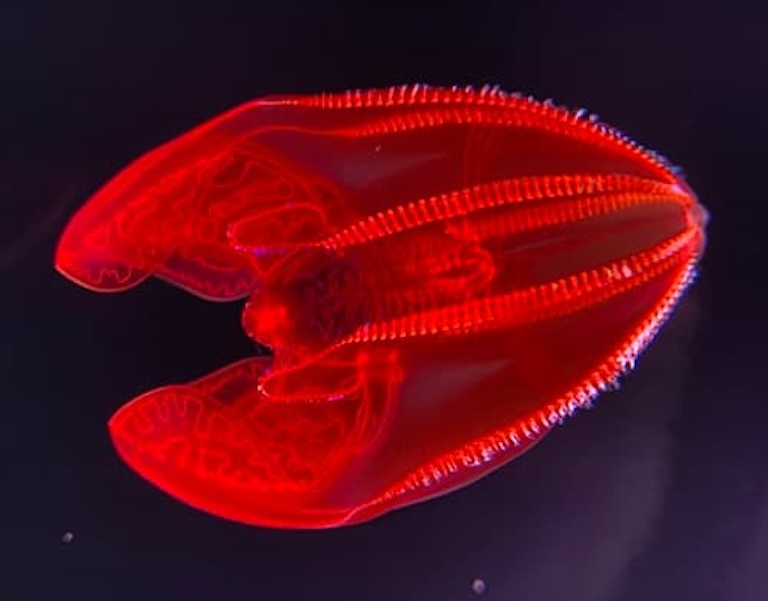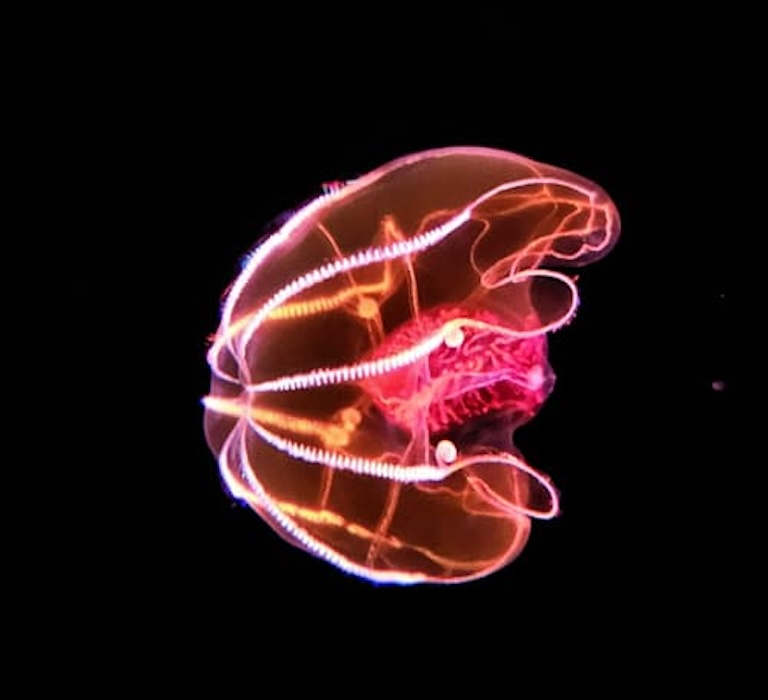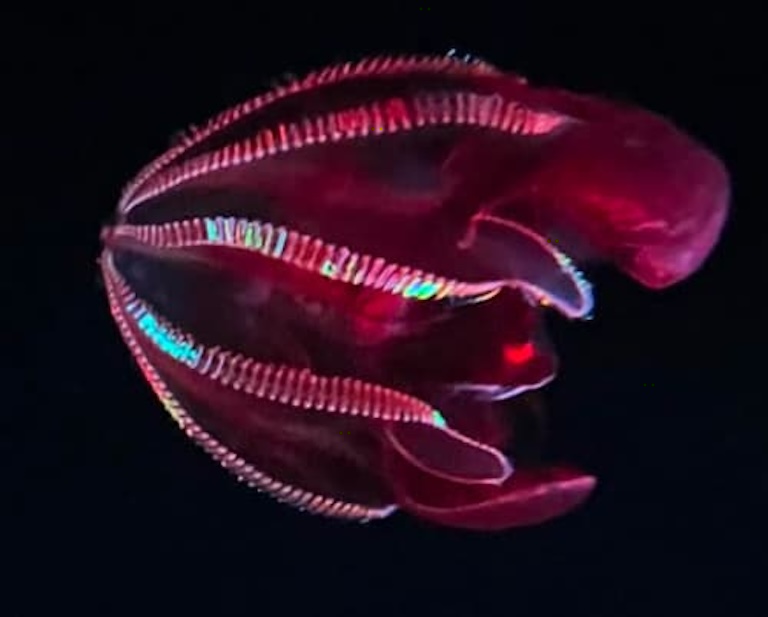Bloodybelly Comb Jelly Profile
As far as jelly-based life forms go, Cnidarians (jellyfish) get most of the attention. They have the cooler name, they can kill you, they’re also found in lakes.. but there’s an entire phylum of oft-overlooked animals swimming about down there. Animals with hairs instead of tentacles, and who use combs to move.
One of the coolest-looking of them all is an animal whose name sounds like an obscure playground nursery rhyme insult: the bloodybelly comb jelly.

Bloodybelly Comb Jelly Facts Overview
| Habitat: | 250m to 1500m deep marine |
| Location: | North Pacific Ocean |
| Lifespan: | Unknown |
| Size: | Up to 10cm |
| Weight: | Not reported |
| Colour: | Deep red to pale purple |
| Diet: | Organic matter, marine arthropods |
| Predators: | Unknown, likely most bigger animals |
| Top Speed: | Slow |
| No. of Species: | 1 |
| Conservation Status: | Not Listed |
Bloodybelly comb jellies, often referred to as BBCJ by lazy animal bloggers, may resemble jellyfish at first squish, but they diverged an unfathomably long time ago; long before such luxuries as spinal cords, teeth, or even bilateral symmetry had been invented.
Comb jellies are a small but phenomenally ancient phylum that we are only just starting to get our heads around.
The BBCJ, as an open ocean, deep-sea jelly is a particularly flimsy piece of kit, so our ignorance is compounded by our inability to get a decent look at one.
Thankfully, marine researchers are absolute geniuses and have come a long way in making it easier.
Interesting Bloodybelly Comb Jelly Facts
1. They’re an evolutionary link
Jelly doesn’t fossilise well, so our understanding of such animals is limited. Fossils of Ctenophores date back over 500 million years but genetics can also tell us some things about how old a line is, and some estimates put the divergence of the Ctenophores from the Cnidarians as far back as 1.2 billion years ago.
This is a sickeningly distant time that stretches the imagination, but suffice it to say it was somewhere around twice as long ago as the point at which animals were starting to figure out bilateral symmetry.
You, as a tetrapod, are bilaterally symmetrical. This means you likely have an arm on both sides, a left and a right eye, and fantastic genitals that sit somewhere in the middle and are more or less mirrored. This is quite a new design, relative to the existence of the animal kingdom, and for the longest time, animals were purely radially symmetrical.
We still have a bunch of those: starfish, urchins and jellyfish are all good examples of animals that don’t really have a left or a right.
Ctenophores aren’t quite radially symmetrical, but they’re not quite bilateral either, and perhaps represent an intermediate between the two. 1 https://inaturalist-open-data.s3.amazonaws.com/photos/335388616/medium.png

2. They’re painfully old
BBCJ’s, then, are prehistoric even by prehistoric standards, at least by some estimates.
The first true tetrapod fossils date back to around 380 million years ago, and the first of our four-footed fishy ancestors likely schlepped out of the muddy shallows onto land around 400 million years ago, maybe a little less.
When the descendants of all living land vertebrates first stopped to take a breath and survey this new environment – an environment where plants had only existed for 70 million years – Ctenophores were already over 800 million years old. And that’s the conservative estimate. They could be as old as 1.5 billion years.
Dinosaurs would be invented for another 150 million years. 2
3. They’re predators
So, what has a jelly-like this been doing all this time? It’s possible that they evolved before predation arrived as a survival strategy, though it’s more likely they were some of the pioneers in this regard.
Today, all known species, including the BBCJ are predators, taking in smaller organisms like crustaceans and fish larvae and smaller animals.
Despite looking simple, they’re more complex than sponges and have muscles, nervous systems and the ability to muffle the screams of their prey. 3
4. They obscure panicking prey items
As Ridley Scott chillingly reminds us, “In space, no one can hear you scream”. Likewise, inside the BBCJ, nobody can see you flash. That’s not a great marketing tagline, but the principle still applies.
The light production, or bioluminescence, of this odd animal, is thought to be a mechanism by which it obscures the bioluminescence of its prey items, essentially stifling its cries for help and preventing its food from giving away the jelly’s location to others, bigger animals who might want to eat it.
Because these strange creatures are predators, rippling through the inky water on iridescent cilia, moving ominously like an alien ship through space,
5. They have counter-illumination
Another great function of their bioluminescence is for camouflage. This might sound backwards, but it’s a clever solution to an interesting problem.
When the sun goes down in the evening, it doesn’t really change colour. The reddening of our life-giving nuclear orb and of the sky around it comes from the fact that it’s passing through the atmosphere at an angle as a result of a phenomenon called Rayleigh scattering.
The more air the light passes through, the more it stands a chance of bumping into some of the molecules in it and getting reflected. Blue light, with its higher in frequency than red light, passes through more space in the same amount of time, increasing the chance that it’ll bump into something.
So, more red light than blue light gets through, changing the colour balance we receive on the ground and the image of our skies at the beginnings and ends of the day.
And this happens in the ocean, too. Red light slips through the water far further, reaching deeper levels than the easily reflected blue. By the time it reaches the habitat of the BBCJ, it’s almost all red. So, animals like this need to be emitting dim red light in order to camouflage themselves against it.
And good camo is super important for an animal made of jelly. 4

6. They’re extremely fragile
Ctenophores are a small phylum with a surprising amount of diversity. Commonly, the species that live in shallow or coastal waters are more robust, but these deep-sea variants are notoriously delicate.
It’s hard enough to bring one to the surface, let alone keep it alive once there, so research on these animals is limited.
Fortunately, rover technology is progressing in leaps and bounds, and unmanned vehicles now patrol the oceans on behalf of research teams from various institutions. Not enough, still, but far better than before!
And this allows marine biologists to view animals like this in their natural habitats, discovering new things about the way they operate without risking exploding them during decompression.
7. Everything is done via cilia
Cilia are often described as hairs, but they’re actually a membrane-bound organelles that serve a very important function in motility, most often at the cellular level. They are found in the back of your throat to make sure all that important mucous moves down instead of up, and in the ocean, they’re found all over microscopic animals to help them ripple their way through the viscous fluid they inhabit.
In comb jellies, cilia are found in long bands that run along its body, and they’re some of the longest examples known in the animal kingdom. Ctenophores are the largest animals to move using these organelles, in a strategy that evolved over a billion years ago and remains the best example of “if it ain’t broke, don’t fix it”.
These outer cilia propel the animal through the water and are responsible for the shimmering look they have in videos. They don’t actually produce rippling light but instead reflect the light of the camera as they move.
Inside the jelly are more cilia, which capture and waft organic matter and small organisms caught in the jelly through the gastric gauntlet of enzymes. 5
8. They don’t use their anus enough
This is a common complaint and one that the BBCJ seemingly has little excuse for. While they have anal pores for excreting waste, most of the unwanted organic matter gets regurgitated via the mouth.
Nobody knows why they’re butt shy, but perhaps their cilia are so effective they don’t need to bother with the anus all that often.
9. MBARI have one alive
The Monterey Bay Aquarium Research Institute is the first human creation to house a life BBCJ. Through trial and error, they’ve improved the collection and accommodation of these animals to the point where they’re not brought up as much and can be kept alive in an aquarium.
But accomplishing this in itself has taught us a lot about these animals. They are extremely sensitive to oxygen levels and temperature, both of which are pretty stable in the deep ocean.
And this highlights the fragility of such a species in the face of rising sea temperatures and changing pH.
The fact that the BBCJ can now be studied in ex-situ will hopefully mean a whole bunch of new discoveries are just around the corner.
Bloodybelly Comb Jelly Fact-File Summary
Scientific Classification
| Kingdom: | Animalia |
| Phylum: | Ctenophorea |
| Class: | Tentaculata |
| Order: | Lobata |
| Family: | Lampoctenidae |
| Genus: | Lampocteis |
| Species: | Cruentiventer |
Fact Sources & References
- “Ctenophora”, Science Direct.
- “The Cambrian Explosion”, Fossil Museum.
- D Y Wang (1999), “Divergence time estimates for the early history of animal phyla and the origin of plants, animals and fungi”, National Institute of Medicine.
- Real Science (2023), “Why Is (Almost) All Bioluminescence in the Ocean?”, YouTube.
- MBARI (Monterey Bay Aquarium Research Institute) (2020), “Weird and Wonderful: The bloody-belly comb jelly, a deep-sea fireball”, YouTube.
